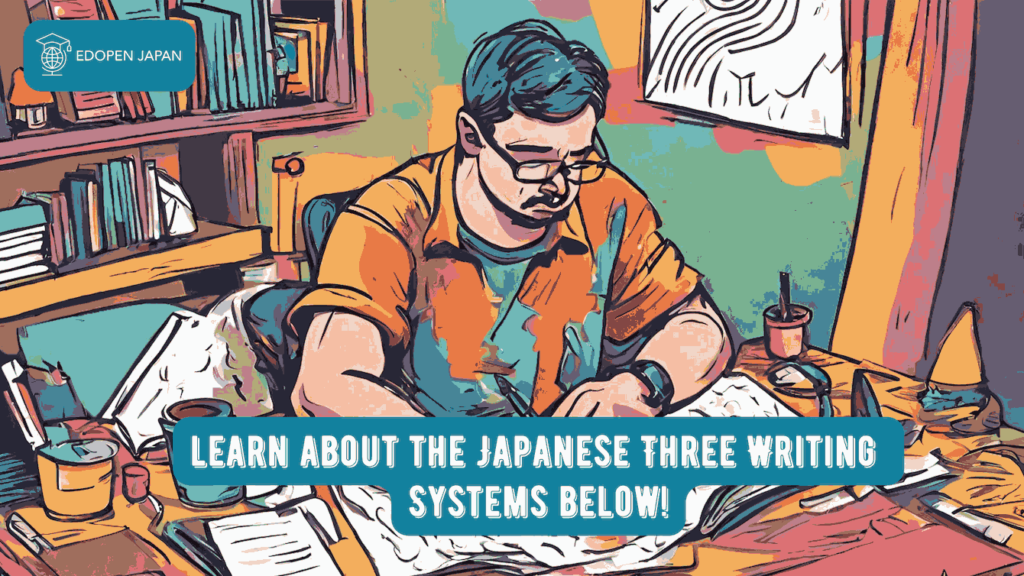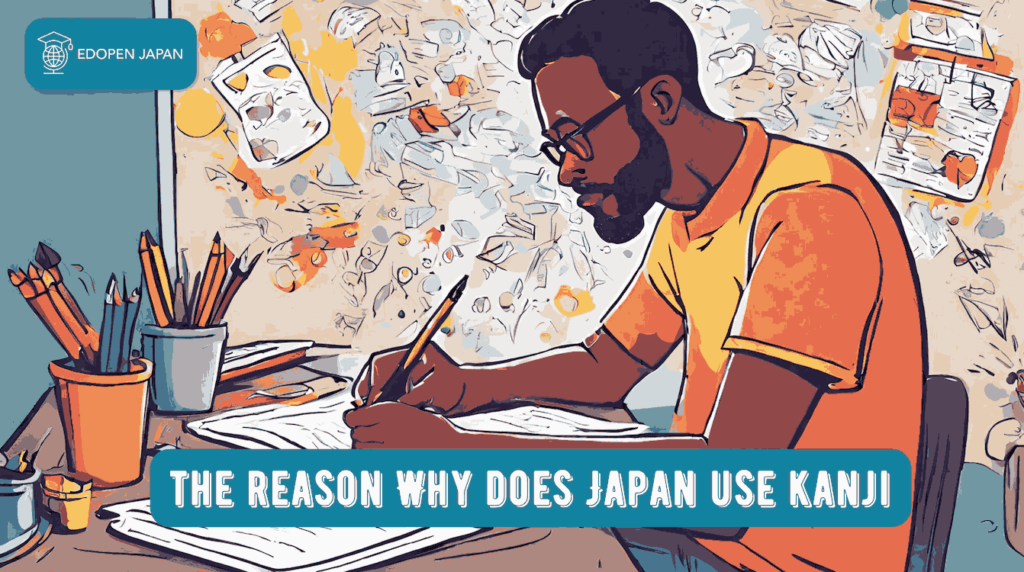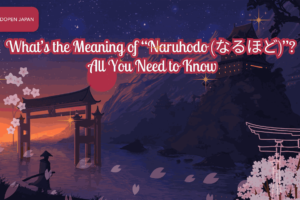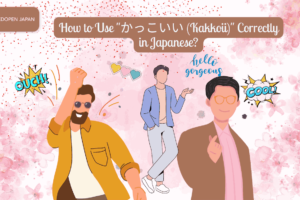Writing skills are very important when learning Japanese. Not only do you need to be able to write by hand, but you also need to understand the Japanese writing system in order to write job applications, reports, presentations, and many other administrative tasks.
For those of you who are looking for a guide to learn how to write Japanese correctly. And also for those of you who want to master how to write Japanese correctly and easily. then we present The article on how to write Japanese below is the right answer for you!
We will comprehensively discuss the concept of Japanese writing, in-depth understanding of the 3 Japanese writing systems, how to master Kanji writing, and tips.
You can also learn Japanese quickly and effectively, please have a look at the link below.
Contents
1. Is it easy to learn Japanese writing?

Sorry, the answer is no. Japanese writing consists of three primary systems, hiragana, katakana, and kanji, in addition to Arabic numerals and the Roman alphabet for public place indications.
Learning Japanese is often deemed challenging due to its complex writing system.
Despite this complexity, hiragana and katakana offer a refreshing respite as they are comparatively effortless to master. And learning both of them is sufficient for achieving JLPT N5 and N4 proficiency. Additionally, learning Kanji is also essential.
If you can consistently implement a good learning system and practice regularly, you can easily master the Japanese writing system. Eventually, you will enjoy writing each component of Kanji and other Japanese writing systems.
2. How can I learn to write in Japanese?

Begin by learning how to write hiragana. Master all of its characters. Understand and memorize all the characters of this writing system as quickly and clearly as you would with the alphabet of your native language. Then, proceed to learn katakana.
The similarity in the number and pronunciation of hiragana and katakana will make it much easier for you to learn these two main writing systems in Japanese.
Learning Japanese starts with mastering hiragana and katakana. These provide a solid foundation to build on. Without them, achieving mastery in Kanji becomes more of a fantasy.
Read also: 10 Best Ways to How to Learn Japanese Online for FREE
3. Japanese Three Writing Systems

To understand the Japanese writing system, you’ll need to learn three key methods: hiragana, katakana and kanji. Hiragana is a phonetic letter that represents each syllable in Japanese. The word hiragana means “flowing” or “simple”.
It’s used to write okurigana and furigana. Okurigana are kana characters that follow behind the kanji. On the other hand, furigana are hiragana letters written above the kanji to help with their pronunciation. Hiragana has several functions like writing okurigana for verbs, adjectives, and particles in a sentence.
Also, hiragana is used in informal writing
To write vocabulary and to produce furigana to facilitate pronunciation of complex kanji. In contrast, Katakana has the same pronunciation as Hiragana, but the letters are different and has a distinct use. Katakana is only applied for transcribing foreign words into Japanese.
Therefore, the function of Katakana is exclusive for this purpose; Transcribing foreign words, emphasizing text, using onomatopoeia, writing technical and scientific terms, and naming plants, animals, and even Japanese companies for emphasis are important aspects of writing.
Hiragana and katakana are simple to learn, and with intense study for just one month, you can master them easily. Additionally, learning kanji was made easier once hiragana had been thoroughly understood.
Read also:
The Hardest Kanji in Japanese
The Most Complete & Essential JLPT N3 Kanji
4. Japanese Writing Steps

Please note that Japanese can be written both horizontally and vertically. Vertical writing can often be found in novels, Japanese newspapers, and other forms of media, but most common public publications are typically written horizontally, like the English alphabet. When writing vertically, the text is arranged from top to bottom with columns of text progressing from right to left.
If you write horizontally, Japanese text is written from left to right with some lines dipping downwards. To master the Japanese writing system, here are the steps to follow:
(1) Start writing Hiragana
There are 48 basic hiragana syllable characters with the following specifications:
- 5 Single vowels: あ (a), い (i), う (u), え (e) and お (o)
- 42 combined consonant and vowel syllables with exceptions:
へ which is pronounced “e” only without h when used as a particle
を which is pronounced “o” only without w when used as a particle and certain vocabulary.
ゐ (wi) and ゑ (we) which are only used for some special names. They are pronounced as “i” only and “e” only respectively without the consonant letter w in front of them. These two characters are also rarely introduced for beginners. - 1 single consonant letter ん pronounced “n” or “ng”
In hiragana writing, you can use the hiragana guide table, just follow the numbers that show the stroke order and the arrows that show the stroke direction.
(2) Writing Katakana
Currently, there are 46 katakanas used in Japanese.
There are 2 pairs of characters that are very similar in katakana. They are シ (shi) and ツ (tsu) and ソ (so) and ン (n).
The difference in the direction and slope of each character should be noted and not reversed. More practice will make it easier for you to master these 4 characters.
(3) Writing Kanji
There are a total of 2,136 Jōyō Kanji (常用漢字) required to reach the level of fluency in Japanese language and literature.
In Japan, junior high school students are usually expected to have mastered all of these kanji.
You can practice writing kanji with a variety of methods that have been highly developed today, including:
- Repetitive writing
- Using the picture mnemonic method
- Using character etymology
and also a variety of other methods.
5. Why does Japan use kanji?

For those wondering, why doesn’t Japan use an uncomplicated romaji system? Kanji simplify reading Japanese. They make sentences shorter, clearer and more precise. Additionally, when mixed with hiragana, Japanese sentences turn out to be more attractive and effortless to read. If kanji were not used, sentences would be longer, more ambiguous and more confusing.
Furthermore, kanji have pictures that help to explain the meanings of words in the sentence. Kanji also do not require gaps between words, which boosts the fluency of reading.
6. Why You Should Learn Kanji?

There are 3 key reasons to master Kanji writing if you want to become proficient in Japanese.
Firstly, it helps you understand sentences in Japanese fast and well. Kanji is composed of intricate strokes, so if you learn the meaning of these characters, you can easily learn hiragana and katakana since they require less and simpler strokes compared to kanji.
Secondly, it prevents confusion when interpreting characters with the same pronunciation and hiragana syllables. In Japanese, there are often words with identical pronunciation but different kanji, leading to misunderstandings. For instance, 話す means “to speak,” whereas 離す means “to let go or separate,” and other characters have similar problems.
Thirdly, you’ll save a lot of effort in Japanese writing by mastering kanji. Knowing kanji writing will make anything related to administrative matters more comfortable. Imagine having to write your address in hiragana. It would be difficult.
Do you have another opinion? Please share in the comments.
7. Concept of Kanji Stroke Order

There are a few key rules that you need to remember about kanji strokes, including:
- Kanji strokes start from top to bottom and from left to right.
- When there are horizontal and vertical strokes that cross, the horizontal strokes are written first. Then the vertical strokes follow.
- The center vertical stroke is written before the outer symmetrical part.
- Kanji that have a square shape consist of only 3 strokes, namely 1 leftmost stroke and the second stroke for the upper and right sides that are connected, and 1 bottom stroke.
- Always start each stroke vertically, horizontally or diagonally from the top to the bottom or left to right first.
Any additions? Please do share what you have thought.
8. The 5 Simple Tips to Master Kanji

Here are 5 simple tips that you can do to master the Kanji writing system. Your consistency and practice will then be the key to your success.
What are the 5 simple tips? They are:
- Understand the Kanji Radical or Kanji Stroke. Slowly, start to understand Kanji radicals. This will help you to understand Kanji faster.
However, if it is difficult, you can also try to understand the strokes and practice writing them as much as possible to be able to remember them. - Use Dictionary. Use a dictionary. You can use an online dictionary or a manual dictionary.
Reading the definitions of each kanji written in the dictionary with Japanese explanations will enrich your knowledge and vocabulary. - Do the Kanji Drills.
- Read Articles and Write Each Kanji. After understanding the strokes, radicals and definitions of kanji. The next task is how to find the use of these Kanji.
You can do this by reading articles and writing down example sentences and vocabulary that use these Kanji. - Set Goals. Define your goals! This will help you to stay on track and stay motivated in the whole process!
Conclusion
So that’s some content about Japanese writing that we provide along with the right tips that you can try in the future. Please share your experiences in learning and understanding Japanese writing.
See you in the next article!













